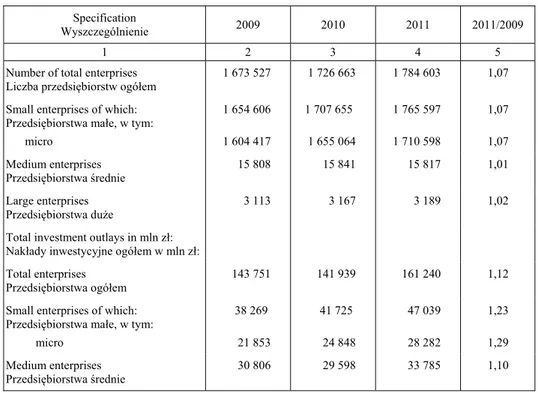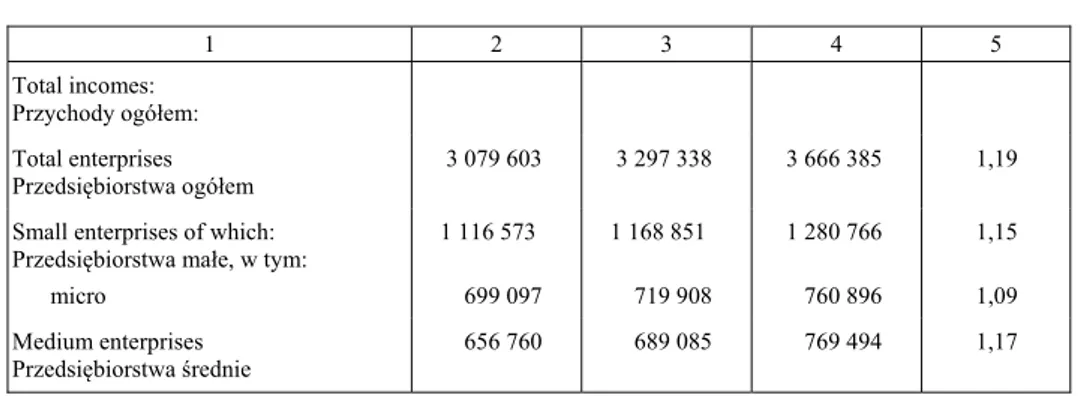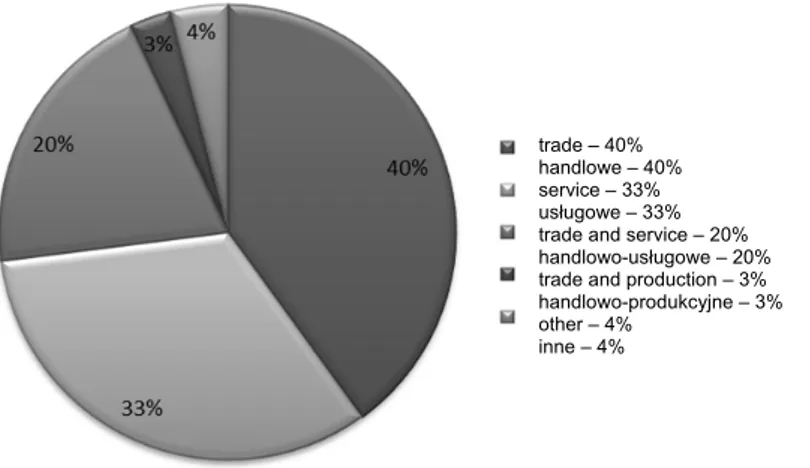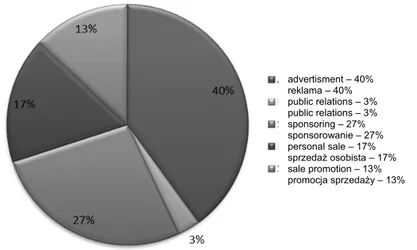pISSN 1899-5241 eISSN 1899-5772
Journal of Agribusiness
and Rural Development
www.jard.edu.pl
3(29) 2013, 193-204
Copyright © Wydawnictwo Uniwersytetu Przyrodniczego w Poznaniu
DIRECTIONS OF DEVELOPMENT OF SMALL
AND MEDIUM ENTERPRISES IN POLAND
Joanna Szwacka-Mokrzycka
Warsaw University of Life Sciences
Abstract. The private sector, dominated by small and medium enterprises (SME), has been rapidly developing in Poland. Small and medium enterprises are defined as econom-ic entities hiring not more than 250 employees and have turnovers lower than 50 million euros per year. The functioning of small and medium enterprises supports a decrease in unemployment, contributes to introduction of innovative operations and products as well as significantly influences GDP generation. The SME sector faces many barriers limiting their development. They include mainly social, financial and law barriers. Operations of the Polish Agency for Enterprise Development, Academic Business Incubators and other entities support small entrepreneurship. Recently, marketing in small and medium enter-prises has particularly influenced their survival. A marketing programme consists of four elements a product, price, distribution, and promotion and is described as the marketing mix. In the paper, results of research in randomly selected enterprises of the SME sector are presented. The aim of the research was to diagnose a range of marketing operations’ use in these companies. The conducted research displays that marketing activity is used mainly for promotion in the investigated enterprises and to a small extent for managing a product’s portfolio in a firm.
Key words: small and medium enterprises, directions of enterprises’ development, speci-ficity of marketing in small and medium enterprises
STATE OF THE ART
play a significant role in the world economy because their share in value formation has been continuously increasing. Development of the service sector as well as innovations of production technologies contribute to the SME expansion. The increasing role of small and medium enterprises is also caused by changes on the market of production factors, political issues and also, to a significant extent, by promotion of entrepreneurial culture [Kurzawska and Lisiewicz 2003]. The following features are the most often listed advantages of entrepreneurs [Przedworska 2008]:
– independence and autonomy in taking decisions, – simple organization structure,
– lack or minimal bureaucracy, which facilitates negotiations with a costumer, – innovativeness, which more often occurs in small enterprises than big
corpora-tions.
Apart from advantages generated by small and medium enterprises for their owners, there are also some barriers:
– limited access to financial resources,
– responsibility and risk of failure lies of an owner,
– more difficult share of work because of a small number of employees, – limited market for products or services,
– limited budget for marketing purposes.
Important input in development of literature of efficiency of SME functioning was performed by Kurzawska and Lisiewicz [2003]. According to their research, the role of the SME sector can be considered from the perspective of effects on the whole econo-my, so [Kurzawska and Lisiewicz 2003]:
– employment – small and medium enterprises provide and create workplaces for the majority of employees in Poland,
– production – the SME sector participates considerably in GDP formation,
– technical progress – small and medium enterprises have an increasing share in implementation of innovations,
– stabilization – during a recession, they have more chances for surviving,
– regional decentralization – lack of special infrastructural requirements allows to set up enterprises in places which are often not profitable for big corporations, – functioning of SME supports reduction of unemployment.
According to research of theoreticians as well as practitioners , marketing in small and medium enterprises is a condition for their stay in the market. Andruszkiewicz [2011] perceives a possibility of the use of marketing in SME in institutional and func-tional dimensions. Contemporarily, the survival of a small enterprise on the market depends often on its orientation in marketing rules and instruments [Kotler 1994].
INTRODUCTION
Dynamic growth and development of the SME sector has been taking place recently, despite the crisis which has spread through the contemporary economy. Medium and small enterprises (SME) play a significant role in the world economy because their participation in the generation of gross domestic product has still been increasing. The growing role of small and medium enterprises is also caused by changes in the markets of production factors, political conditions as well as to a wide extent, promotion of a culture of entrepreneurship.
METHODOLOGY
The research included looking for answers for the following questions: – what are the reasons for local entrepreneurship development?
– if the SME sector’s development can be a base for economic activation and un-employment reduction?
– to what extant do SME use marketing operations for sale development? The following research hypothesis were established:
1. Small and medium enterprises play a significant role in entrepreneurship activa-tion.
2. An increasing role of SME is caused by their participation in formation and shar-ing of gross domestic product, activation of product and technological innova-tions.
3. Suitable programmed marketing operations influence SME development.
There was conducted questionnaire research in a form of direct interview with man-agers or owners of small and medium enterprises. Research was realized in a group of randomly selected enterprises of the SME sector in the Nowy Duninów commune in 2011 [Paradowska 2011]. The objective of the research was an analysis of marketing mix functioning in these companies, its understanding, and an aim of use of its instru-ments for managers.
SPECIFICITY OF FUNCTIONING OF SMALL AND MEDIUM ENTERPRISES
Definition of SME
The European Union takes mainly qualitative criteria as a base for SME defining. They are based on such categories as:
– number of employees, – balance sheet total,
– turnover: so income from the whole activity or from basic, operational activity (sale of products, services and goods)
The EU recommendation 2003/361 describes an enterprise as “any entity engaged in an economic activity, irrespective of its legal form”. So in other words, according to this definition of SME, an enterprise means any economic entity regardless of organizational or legal character of a form [Rekomendacja... 2003].
The recommendation focuses on real SMEs and tries to eliminate a group of entre-preneurs of considerably higher economic power than real SMEs outside this category (Table 1).
The main features of this definition involve: – the criterion of the number of employees,
– the economic criterion (annual turnover or balance sheet total).
Table 1. Criteria of SMEs classification in the European Union since 1.01.2005 Tabela 1. Kryteria klasyfikacji M P w Unii Europejskiej od 1.01.2005 roku
Criterion Kryterium
Micro Mikro
Small Małe
Medium rednie
Number of employees Wielkoć zatrudnienia
< 10 < 50 < 250
Turnover (Euro) Wartoć obrotu (Euro)
≤ 2 mln ≤ 10 mln ≤ 50 mln
Balance sheet total (Euro) Suma aktywów bilansu (Euro)
≤ 2 mln ≤ 10 mln ≤ 43 mln
Source: Rekomendacja... [2003]. ródło: Rekomendacja... [2003].
According to this definition enterprises in the European Union are divided into: – autonomous enterprises,
– partner enterprises, – linked enterprises.
A role of the SME sector can be considered also from a perspective of effects on the whole economy:
– employment – small and medium enterprises provide and generate work places for majority of the employed in Poland; moreover, the SME sector guarantees more stable workplaces than big corporations; additionally, in a situation of liqui-dation of a small or medium company, it does not contribute on a large extent, to an increase in unemployment as in a case of a big company;
– technological progress –SME have had increasing participation in implementation of innovations, which are conditions for their longevity and development;
– stabilization – during recession SMEs have considerably higher chances of surviv-ing because of better adaptation possibilities to new conditions of functionsurviv-ing so they do not cause increase in unemployment;
– regional decentralization – lack of specific infrastructural requirements allows for the establishment of companies in places often not profitable for big corporations; – capital mobilization – small and medium enterprises are mainly financed by re-sources of their owners, so private persons; so money which could be used for consumption or savings contributes new products to the economy and influences increase in GDP.
The number of SME has been increased by about 7% in 2009-2011, relative to oth-ers, the increase was the largest (Table 2). In the same time it was observed that the crucial increase of investment outlays in SME (by about 23% in 2011 in relation to 2009) and by about 29% in mikro enterprises (Table 2). It is worth to mentioning that the increase of investment outlays in SME was in 2009-2010 more then two times high-er than in total enthigh-erprises and three times highhigh-er than in medium enthigh-erprises. At the same time it is observed that there is an essential increase in incomes of SME (by about 15%), in comparison to19% in the group of total enterprises (Table 2).
Table 2. Basic information on SME in 2009-2011 Tabela 2. Podstawowe dane o M P w latach 2009-2011
Specification
Wyszczególnienie 2009 2010 2011 2011/2009
1 2 3 4 5
Number of total enterprises Liczba przedsiębiorstw ogółem
1 673 527 1 726 663 1 784 603 1,07
Small enterprises of which: Przedsiębiorstwa małe, w tym:
micro
1 654 606
1 604 417
1 707 655
1 655 064
1 765 597
1 710 598
1,07
1,07
Medium enterprises Przedsiębiorstwa rednie
15 808 15 841 15 817 1,01
Large enterprises Przedsiębiorstwa du e
3 113 3 167 3 189 1,02
Total investment outlays in mln zł: Nakłady inwestycyjne ogółem w mln zł:
Total enterprises Przedsiębiorstwa ogółem
143 751 141 939 161 240 1,12
Small enterprises of which: Przedsiębiorstwa małe, w tym:
micro 38 269 21 853 41 725 24 848 47 039 28 282 1,23 1,29 Medium enterprises
Przedsiębiorstwa rednie
Table 2 – cont. / Tabela 2 – cd.
1 2 3 4 5
Total incomes: Przychody ogółem:
Total enterprises Przedsiębiorstwa ogółem
3 079 603 3 297 338 3 666 385 1,19
Small enterprises of which: Przedsiębiorstwa małe, w tym:
micro
1 116 573
699 097
1 168 851
719 908
1 280 766
760 896
1,15
1,09
Medium enterprises Przedsiębiorstwa rednie
656 760 689 085 769 494 1,17
Source: own elaboration on the base of Statistical Yearbook [2012]. ródło: opracowanie własne na podstawie Rocznika Statystycznego [2012].
RANGE OF MARKETING INSTRUMENTS USED IN SME
Contemporarily, survival of a small enterprise on the market depends on a level of its orientation within marketing rules and instruments.
Criteria of the target market selection
Utilisation of the marketing approach in company’s operation means perceiving the market as a group of non-homogenous purchasers, who are different in terms of needs, income level, motives of the purchase, etc. Selection of the target market involves de-termination: how many and which segments will be in the field of the company’s activi-ty. The main role is played by the following criteria of target market selection [Szwacka-Mokrzycka 2012]:
1. Size and pace of the segment.
2. Structural attractiveness of the segment. 3. Objectives and sources of the company.
Ad. 1. Size and pace of the segment is a basic criterion of selection of the target market, which should ensure enough level of sale and profit for the company. This crite-rion has a subjective dimension. A narrow, specialist market can have big capacity for a small firm whereas it can be unattractive from the perspective of objective realization and possibilities of a big firm.
Ad. 2. Structural attractiveness of the segment is a concept including many ele-ments. The most important ones are: dangers generated by strong competitors placed inside the segment as well as the possibility of entrance of new companies and occur-rence of substitute products.
human, material and financial resources it disposes allow it to satisfy the service of a particular market segment.
Marketing instruments used by SME
A marketing-mix is a set of marketing instruments, which is used by a company in order to realize its objectives on a selected market. The basic marketing programme consists of four elements [Szwacka-Mokrzycka 2012]:
– product, a good or service aiming at fulfilling particular costumer’s needs; – price, a value of a product or service;
– distribution, described as a place, way and time of providing a product to a cos-tumer;
– promotion, marketing communication with a costumer.
Small and medium enterprises take decisions on forming of an assortment structure and brand portfolio within the product policy. Brand is created by logo, characteristic colours and product packaging. Many times small and medium enterprises offer prod-ucts non-marked with a brand in order to limit costs on marketing operations. However, increasing competitiveness has forced SME to implement a carefully considered brand strategy in order to improve a market position.
Small and medium enterprises offering products or services also have to determine price strategies. A level of prices is influenced by many factors such as: character or uniqueness of an offered product, demand for particular good, costumers’ attitudes, operations of competitors, costs connected with a product, promotion, and distribution. SME determine product prices basing on the following methods:
1. Costing method – average fixed and variable costs as well as target unit margin profit are a basis for price determination. Use of this method should include care-ful estimation of demand for offered products and unit fixed costs. There exists one common disadvantage of all costing methods – they do not take into account real costumers’ willingness for purchasing at a particular price. This method is used by 44% of SME entities [Kaczmarczyk 2002].
2. Demand method – enterprises form prices basing on observations and an analysis of relations between demand and price. Demand forecasting plays an important role here. Unfortunately, demand estimation at the situation of price determination is quite difficult, especially in a situation of introduction of new products on the market. This method of the price calculation is used by 32% of small and medium enterprises.
3. Method basing on prices of competitors – it is the most popular method in SME. Research results show that even 54% of SME determine prices basing on prices of competitors’ products.
As far as a range of used promotion instruments is considered, advertising in news-papers and the internet as well as sponsoring are the most popular ones. Summing up, it can be concluded that SME do not use usual marketing operations. It is typically be-cause of lack of adequate knowledge as well as suitable employees and financial re-sources. They do not realize that an appropriate promotion campaign as well as a properly built image of a company can significantly improve its financial results.
EMPIRICAL RESULTS
The group of respondents consisted of 40% of women whereas 60% of enterprises were managed by men. The research results show that micro enterprises are a majority of companies in the Nowy Duninów commune; their proportion was 90% of the total number of companies.
without employees – 57% bez pracowników – 57% to 10 employees – 33% do 10 pracowników – 33% 10-49 employees – 7% 10-49 pracowników – 7% 50-249 employees – 3% 50-249 pracowników – 3%
Fig. 1. Respondents’ characteristic according to the number of employees Source: own elaboration on the base of Paradowska [2011]. Rys. 1. Charakterystyka respondentów według liczby zatrudnionych
ródło: opracowanie własne na podstawie Paradowskiej [2011].
Micro enterprises hire usually a few persons (1-9 employees); an owner is the only one employee in majority of them. The second group was represented by small enter-prises – 7%. Medium enterenter-prises were the smallest group in the research – only 3% (Fig. 1).
In Nowy Duninów, the SME sector is involved mainly in trade (40%), service (33%), or service and trade (20%) (Fig. 2).
trade – 40% handlowe – 40% service – 33% usługowe – 33% trade and service – 20% handlowo-usługowe – 20% trade and production – 3% handlowo-produkcyjne – 3% other – 4%
inne – 4%
Fig. 2. Characteristics of the researched enterprises according to the field of their operation
Source: own elaboration on the base of Paradowska [2011]. Rys. 2. Charakterystyka badanych przedsiębiorstw według rodzaju
dzia-łalno ci
ródło: opracowanie własne na podstawie Paradowskiej [2011].
production of advertising materials – 13% produkcja materiałów reklamowych – 13%
creations of an enterprise’s image – 11% kreowanie wizerunku firmy – 11%
supervision on en enterprise’s website – 23% nadzór nad stroną www – 23%
supervision on brand’s – 53% nadzór nad komunikacją marki – 53%
Fig. 3. Main tasks of the marketing department in enterprises Source: own elaboration on the base of Paradowska [2011]. Rys. 3. Główne zadania działu marketingu
ródło: opracowanie własne na podstawie Paradowskiej [2011].
department’s operation. A presentation of the company and its products or services usually takes place during cultural and sport events organized in the Nowy Duninów commune and the Płock poviat (Fig. 3). A significant majority of respondents (77%) concluded that marketing supports sale of products or services offered by a company. Only 13% of respondents perceived the term of marketing as an instrument of adver-tisement. The most popular forms of advertisement used by the SMEs in Nowy Duninów include: advertisement in local newspapers and radio, posters, leaflets and brochures provided directly to homes of the commune’s inhabitants.
Entrepreneurs of the Nowy Duninów commune indicated that specific features (41%), an attractive price (30%) and unique features (13%) are the most important ad-vantages of their products (Fig. 4).
characteristic packaging – 3% charakterystyczne opakowanie – 3% unique features – 13%
unikalne wła ciwo ci – 13% high quality – 10% wysoka jakoć – 10%
specific features – 41% specyficzne cechy – 41%
brand – 3% marka – 3%
price – 30% cena – 30%
Fig. 4. The most important assets of products offered by enterprises Source: own elaboration on the base of Paradowska [2011].
Rys. 4. Najwa niejsze atrybuty produktów oferowanych przez przedsię bior-stwa
ródło: opracowanie własne na podstawie Paradowskiej [2011].
A low price compared with competitors was also one of the important assets of a product or service. An aspect connected with price is product quality. Respondents who accepted high product quality as an important feature of their products represented 10%. According to the investigated population – a product brand (3%) as well as its characteristic packaging (3%) are less important for costumers.
Majority of entrepreneurs from Nowy Duninów (75%) implement promotion opera-tions (Fig. 5).
advertisment – 40% reklama – 40% public relations – 3% public relations – 3% sponsoring – 27% sponsorowanie – 27% personal sale – 17% sprzedaż osobista – 17% sale promotion – 13% promocja sprzedaży – 13%
Fig. 5. Elements of promotion used by enterprises
Source: own elaboration on the base of Paradowska [2011]. Rys. 5. Elementy promocji wykorzystywane przez przedsiębiorstwa
ródło: opracowanie własne na podstawie Paradowskiej [2011].
CONCLUSIONS
Small and medium enterprises (SME) play a significant role in the global economy because their participation in the generation of gross domestic product has still been increasing. Functioning of the SME sector bring many advantages for owners as well as the whole economy. Unfortunately, a limited access to financing sources causes consid-erable barriers for further development. Contemporary, survival of a small enterprise on the market depends on a level of orientation in marketing rules and instruments. The conducted research displays that marketing activity is used mainly for promotion in the investigated enterprises and to a small extent for managing a product portfolio in a firm.
REFERENCES
Andruszkiewicz K., 2011. Marketing. Podręcznik akademicki. Wyd. Dom Organizatora, Toru . Czubała A., 2001. Dystrybucja produktów. PWE, Warszawa.
Kaczmarczyk S., 2002. Kształtowanie cen oraz polityka dystrybucji. In: Zarządzanie marketin-gowe w polskich przedsiębiorstwach. Stan, zastosowanie, tendencje i kierunki zmian. Raport z badania. Wyd. Uniwersytetu Mikołaja Kopernika, Toru , 88.
Kasperska-Moro D., 2010. Funkcjonowanie małych i rednich firm produkcyjnych w ła cuchu dostaw. Wyd. AE w Katowicach, Katowice.
Kotler Ph., 1994. Marketing. Analiza, planowanie, wdra anie i kontrola. Wyd. Gebethner i S-ka, Warszawa.
Paradowska A., 2012. Marketing mix w małych i rednich przedsiębiorstwach gminy Nowy Duninów. Master thesis. SGGW, Warszawa.
Przedworska K., 2008. Praktyczny marketing w małej firmie. Wyd. Złote My li, Gliwice. Rekomendacja Komisji Europejskiej 2003/361/WE o definicji mikro, małych i rednich przedsię
-biorstw. 2003. Dz.U. WE 124/2003. Rocznik Statystyczny. 2012. GUS, Warszawa.
Szromnik A., 2004. Marketing terytorialny. Problemy kształtowania strategii marketingowej miast i regionów. In: Badania przestrzenne rynku i konsumpcji a polityka regionalna Unii Eu-ropejskie. Ed. J. Mazurek-Łopaci ska. Wyd. AE we Wrocławiu, Wrocław, 120-121. Szwacka-Mokrzycka J., 2011 a. A study on food brand. University of Life Sciences Press,
War-saw.
Szwacka-Mokrzycka J., 2011 b. Znaczenie turystyki w strategii rozwoju gminy. Studia Ekono-miczne i Regionalne. T 5/1. Wyd. PSW im. Papie a Jana Pawła II w Białej Podlaskiej, Biała Podlaska.
Szwacka-Mokrzycka J., 2012. Marketing – mechanizmy gry rynkowej. Wyd. SGGW, Warszawa.
KIERUNKI ROZWOJU MAŁYCH I REDNICH PRZEDSI BIORSTW
W POLSCE
Streszczenie. Sektor prywatny, zdominowany w Polsce przez małe i rednie przedsię bior-stwa, rozwija się dynamicznie. Małe i rednia przedsiębiorstwa są definiowane jako jed-nostki ekonomiczne, zatrudniające do 250 pracowników, o obrotach rocznych nie prze-kraczających 50 mln euro. Funkcjonowanie małych i rednich przedsiębiorstw niweluje bezrobocie, sprzyja prowadzeniu polityki proinnowacyjnej, a tym samym ma istotny wpływ na generowanie PKB. Nale y jednocze nie podkre lić, e sektor M P napotyka na wiele barier ograniczających ich rozwój. Obejmują one przede wszystkim bariery
spo-łeczne, finansowe i prawne. Działania Polskiej Agencji Rozwoju Przedsiębiorczo ci, Akademickich Inkubatorów Przedsiębiorczo ci i innych instytucji, stanowią wsparcie dla małej przedsiębiorczo ci. W ostatnich czasach coraz więcej uwagi po więca się wykorzy-staniu marketingu w kreowaniu rozwoju M P. Program marketingowy obejmuje cztery elementy, tj.: produkt, cenę, dystrybucję i promocję. W artykule przedstawiono główne wyniki bada przeprowadzonych na próbie M P. Celem bada było okre lenie zakresu stosowania marketingu w badanych przedsiębiorstwach. Badania wykazały, e M P wy-korzystują głównie działania promocyjne oraz w małym zakresie działania związane z za-rządzaniem portfelem produktowym.
Słowa kluczowe: małe i rednie przedsiębiorstwa, kierunki rozwoju przedsiębiorstw, spe-cyfika marketingu w małych i rednich przedsiębiorstwach
Accepted for print – Zaakceptowano do druku: 2.09.2013



![Fig. 1. Respondents’ characteristic according to the number of employees Source: own elaboration on the base of Paradowska [2011]](https://thumb-eu.123doks.com/thumbv2/123dok_br/18339373.351802/8.892.238.639.445.693/respondents-characteristic-according-number-employees-source-elaboration-paradowska.webp)

![Fig. 4. The most important assets of products offered by enterprises Source: own elaboration on the base of Paradowska [2011]](https://thumb-eu.123doks.com/thumbv2/123dok_br/18339373.351802/10.892.232.657.390.622/important-assets-products-offered-enterprises-source-elaboration-paradowska.webp)
